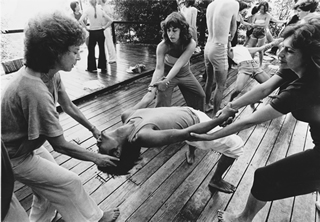Dance of a Lifetime - Page 4
 |
|
|
 |
|
|
 |
|
|
The house that Wurster designed for the Halprins, in collaboration with Larry, also influenced Anna's work, she says.
The house, she wrote, "influenced me and my art on a daily basis."
"A free-flowing connection between inside and outside, a major theme in my own work which would develop through exploration of dance both inside and outside the theater," she wrote. The living room has a view of Mt. Tam.
Shortly after they moved in, Larry suggested building his wife the dance deck. He designed the meandering redwood deck with lighting designer Arch Lauterer.
"I thought it was brilliant," Anna says of Larry's suggestion, adding that she would not have thought of it herself.
"That dance deck had no proscenium arch. It took me straight out into nature," she says. "I didn't like dancing on stages anymore. I don't like being shoved into this little box."
The deck clearly met a need. For several years, during the 1950s, Anna and a partner had been operating a popular dance school in San Francisco. They had also been performing in theaters. But San Francisco did not have much of a dance scene, so Anna was feeling isolated.
And there weren't many places to perform.
"I left the city and began to dance in this invigorating outdoor environment," she wrote.
"I was the first person, because of Larry's influence, who said you don't have to dance on the stage, you can dance on the street, you can dance on the river, you can dance anyplace you decide to be," she says.
Because there were so few dancers in the Bay Area, Anna was soon collaborating with non-dancers, poets, painters, and, soon, a psychoanalyst. Collaborators included dancers A.A. Leath; composers Morton Subotnick, Pauline Oliveros, and Harry Partch; artist Bruce Conner; and self-described 'Zen-Jewish' psychoanalyst Fritz Perls, who, starting in the mid 1960s, led Halprin into the hippie-era Human Potential Movement.
This was the era, dance writer Sally Branes has written, when Halprin "gradually moved from dance as theatrical art to dance as a healing art."
Dance was no longer entertainment. It was a way of understanding the self, of healing both the individual and the world. After Anna came down with cancer in 1972, and survived, healing became an ever more important part of her art.
She did a performance, 'Dancing My Cancer,' went on to work with AIDS sufferers, and wrote a book, Dance as a Healing Art.
As time went on, Ross wrote, "Anna didn't seem to mind whether the results of her experiments were prosaic...or radically unexpected. Her focus was on how to generate movement from a source beyond conscious and deliberate control, and yet remain true to the physical logic of the body."
Too much can be made, however, of Anna's use of dance as a healing art, as an experiential more than an artistic thing. Throughout her career she continued to create dances that were deeply personal and expressive.




